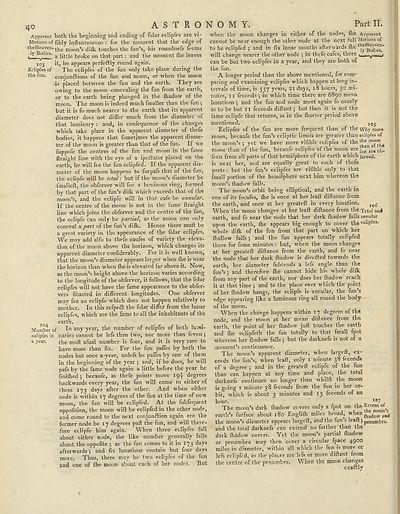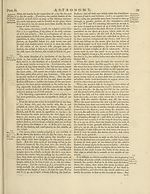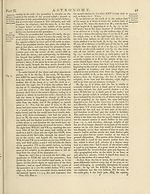Encyclopaedia Britannica, or, a Dictionary of arts, sciences, and miscellaneous literature : enlarged and improved. Illustrated with nearly six hundred engravings > Volume 3, ASS-BOO
(48) Page 40
Download files
Complete book:
Individual page:
Thumbnail gallery: Grid view | List view

40 ASTRONOMY. Part II.
Apparent both the beginning and ending of folar eclipfes are vi- when the moon changes in either of the nodes, fhe Apparent
Motions of fibly inftantaneous: for the moment that the edge of cannot be near enough the other node at the next full Motiom of
theHeaven-the moonrs difk touches the fun’s, his roundnefs feems to be eclipfed ; and in fix lunar months afterwards Ihe1^
. y BPdie!i’ a uttie broke on that part: and the moment (he leaves will change nearer the other node •, in thefe cafes, there , v—
103 it, he appears perfectly round again. can be but two eclipfes in a year, and they are both of
Eclipfes of The eclipfes of the fun only take place during the the fun.
the fun. conjunttions of the fun and moon, or when the moon A longer period than the above mentioned, for com¬
as placed between the fun and the earth. They are paring and examining eclipfes which happen at long in-
owing to the moon -concealing the fun from the earth, tervals of time, is j|57 years, 21 days, 18 hours, mi-
or to the earth being plunged in the lhadovv of the nutes, 11 feconds 5 in which time there are 6890 mean
moon. The moon is indeed much fmaller than the fun ; lunations j and the fun and node meet again.fo nearly
but it is fo much nearer to the earth that its apparent as to be but 11 feconds diftant; but then it is not the
diameter does not differ much from the diameter of fame eclipfc that returns, as in the fhorter period above
that luminary : and, in confequence of the changes
which take place in the apparent diameter of thefe
bodies, it happens that fometimes the apparent diame¬
ter of the moon is greater than that of the fun. If we
fuppofe the centres of the fun and moon in the fame
ftraight line with the eye of a fpeffator placed on the
earth, he will fee the fun eclipfed. If the apparent dia¬
meter of the moon happens to furpafs that of the fun,
the eclipfe will be total: but if the moon’s diameter be
•fmalleft, the obferver will fee a luminous ring, formed
by that part of the fun’s dilk which exceeds that of the
moon’s, and the eclipfe will in that cafe be annular.
If the centre of the moon is not in the fame ftraight
line which joins the obferver and the centre of the fun,
the eclipfe can only be ‘partial, as the moon can only
conceal a part of the fun’s dilk. Hence there muft be
a great variety in the appearance of the folar eclipfes.
We may add alfo to thefe caufes of variety the eleva¬
tion of the moon above the horizon, which changes its
apparent diameter confiderably. For it is well known,
that the moon’s diameter appears larger when Ihe is near
the horizon than when Ihe is elevated far above it. Now,
as the moon’s height above the horizon varies according
to the longitude of the obferver, it follows, that the folar
eclipfes will not have the fame appearance to the obfer-
vers fituated in different longitudes. One obferver
may fee an eclipfe which does not happen relatively to
another. In this refpe& the folar differ from the lunar
eclipfes, which are the fame to all the inhabitants of the
earth.
Number of *n any year> number of eclipfes of both lumi-
eclipfes in naries cannot be lefs than two, nor more than feven;
a year. the moft ufual number is four, and it is very rare to
have more than fix. For the fun paffes by both the
nodes but once a-year, unlefs he paffes by one of them
in the beginning of the year ; and, if he does, he will
pafs by the fame node again a little before the year be
finiftied ; becaufe, as thefe points move 19^- degrees
backwards every year, the fun will come to either of
them 173 days after the other. And when either
node is within 17 degrees of the fun at the time of new
moon, the fun will be eclipfed. At the fubfequent
oppofition, the moon will be eclipfed in the other node,
and come round to the next conjun&ion again ere the
former node be 17 degrees paft the fun, and will there¬
fore eclipfe him again. When three eclipfes fall
about either node, the like number generally falls
about the oppofite as the fun comes to it in 173 days
afterwards ; and fix lunations contain but four days
more. Thus, there may be two eclipfes of the fun
and one of the moon about each of her nodes. But
mentioned.
Eclipfes of the fun are more frequent than of the why more
moon, becaufe the fun’s ecliptic limits are greater than eclipl'es of
the moon’s ; yet we have more vifible eclipfes of the
moon than of the fun, becaufe eclipfes of the moon J<refun ar# ob.
feen from all parts of that hemifphere of the earth which ferved.
is next her, and are equally great to each of thofe
parts : but the fun’s eclipfes are vifible only to that
(mail portion of the hemifphere next him whereon the
moon’s (hadow falls.
The moon’s orbit being elliptical, and the earth in
one of its focufes, fhe is once at her leaft diftahee from
the earth, and once at her greateft in every lunation. IC(j
When the moon changes at her leaft diftance from the Total anJ
earth, and fo near the node that her dark fhadow falls annular
upon the earth, fhe appears big enough to cover the eclipfes.
whole difk of the fun from that part on which her
fhallow falls; and the fun appears totally eclipfed
there for fome minutes : but, when the moon changes
at her greateft diftance from the earth, and fo near
the node that her dark fhadow is direfted towards the
earth, her diameter fubtends a lefs angle than the
fun’s; and therefore fhe cannot hide his whole difk
from any part of the earth, nor does her fhadow reach
it at that time ; and to the place over which the point
of her fhadow hangs, the eclipfe is annular, the fun’s
edge appearing like a luminous ring all round the body
of the moon.
When the change happens within 17 degrees of the
node, and the moon at her mean diftance from the
earth, the point of her fhadow juft touches the earth
and fhe eclipfeth the fun totally to that fmall fpot
whereon her fhadow falls; but the darknefs is not of a
moment’s continuance.
The moon’s apparent diameter, when largeft, ex¬
ceeds the fun’s, when leaft, only 1 minute 38 feconds
of a degree j and in the greateft eclipfe of the fun
than can happen at any time and place, the total
darknefs continues no longer than whilft the moon
is going I minute 38 feconds from the fun in her or¬
bit, which is about 3 minutes and 13 feconds of an
hour. I97
The moon’s dark fhadow covers only a fpot on the tCnt 0 ,
earth’s furface about 180 Englifh miles broad, w^en
the moon’s diameter appears largeft, and the fun’s leaft; penumbra.
and the total darknefs can extend no farther than the
dark fhadow covers. Yet the moon’s partial fhadow
or penumbra may then cover a circular fpace 4900
miles in diameter, within all which the fun is more or
lefs edipftd, as the places are lefs or more diftant from
the centre of the penumbra. When the moon changes
/ exa&ly
Apparent both the beginning and ending of folar eclipfes are vi- when the moon changes in either of the nodes, fhe Apparent
Motions of fibly inftantaneous: for the moment that the edge of cannot be near enough the other node at the next full Motiom of
theHeaven-the moonrs difk touches the fun’s, his roundnefs feems to be eclipfed ; and in fix lunar months afterwards Ihe1^
. y BPdie!i’ a uttie broke on that part: and the moment (he leaves will change nearer the other node •, in thefe cafes, there , v—
103 it, he appears perfectly round again. can be but two eclipfes in a year, and they are both of
Eclipfes of The eclipfes of the fun only take place during the the fun.
the fun. conjunttions of the fun and moon, or when the moon A longer period than the above mentioned, for com¬
as placed between the fun and the earth. They are paring and examining eclipfes which happen at long in-
owing to the moon -concealing the fun from the earth, tervals of time, is j|57 years, 21 days, 18 hours, mi-
or to the earth being plunged in the lhadovv of the nutes, 11 feconds 5 in which time there are 6890 mean
moon. The moon is indeed much fmaller than the fun ; lunations j and the fun and node meet again.fo nearly
but it is fo much nearer to the earth that its apparent as to be but 11 feconds diftant; but then it is not the
diameter does not differ much from the diameter of fame eclipfc that returns, as in the fhorter period above
that luminary : and, in confequence of the changes
which take place in the apparent diameter of thefe
bodies, it happens that fometimes the apparent diame¬
ter of the moon is greater than that of the fun. If we
fuppofe the centres of the fun and moon in the fame
ftraight line with the eye of a fpeffator placed on the
earth, he will fee the fun eclipfed. If the apparent dia¬
meter of the moon happens to furpafs that of the fun,
the eclipfe will be total: but if the moon’s diameter be
•fmalleft, the obferver will fee a luminous ring, formed
by that part of the fun’s dilk which exceeds that of the
moon’s, and the eclipfe will in that cafe be annular.
If the centre of the moon is not in the fame ftraight
line which joins the obferver and the centre of the fun,
the eclipfe can only be ‘partial, as the moon can only
conceal a part of the fun’s dilk. Hence there muft be
a great variety in the appearance of the folar eclipfes.
We may add alfo to thefe caufes of variety the eleva¬
tion of the moon above the horizon, which changes its
apparent diameter confiderably. For it is well known,
that the moon’s diameter appears larger when Ihe is near
the horizon than when Ihe is elevated far above it. Now,
as the moon’s height above the horizon varies according
to the longitude of the obferver, it follows, that the folar
eclipfes will not have the fame appearance to the obfer-
vers fituated in different longitudes. One obferver
may fee an eclipfe which does not happen relatively to
another. In this refpe& the folar differ from the lunar
eclipfes, which are the fame to all the inhabitants of the
earth.
Number of *n any year> number of eclipfes of both lumi-
eclipfes in naries cannot be lefs than two, nor more than feven;
a year. the moft ufual number is four, and it is very rare to
have more than fix. For the fun paffes by both the
nodes but once a-year, unlefs he paffes by one of them
in the beginning of the year ; and, if he does, he will
pafs by the fame node again a little before the year be
finiftied ; becaufe, as thefe points move 19^- degrees
backwards every year, the fun will come to either of
them 173 days after the other. And when either
node is within 17 degrees of the fun at the time of new
moon, the fun will be eclipfed. At the fubfequent
oppofition, the moon will be eclipfed in the other node,
and come round to the next conjun&ion again ere the
former node be 17 degrees paft the fun, and will there¬
fore eclipfe him again. When three eclipfes fall
about either node, the like number generally falls
about the oppofite as the fun comes to it in 173 days
afterwards ; and fix lunations contain but four days
more. Thus, there may be two eclipfes of the fun
and one of the moon about each of her nodes. But
mentioned.
Eclipfes of the fun are more frequent than of the why more
moon, becaufe the fun’s ecliptic limits are greater than eclipl'es of
the moon’s ; yet we have more vifible eclipfes of the
moon than of the fun, becaufe eclipfes of the moon J<refun ar# ob.
feen from all parts of that hemifphere of the earth which ferved.
is next her, and are equally great to each of thofe
parts : but the fun’s eclipfes are vifible only to that
(mail portion of the hemifphere next him whereon the
moon’s (hadow falls.
The moon’s orbit being elliptical, and the earth in
one of its focufes, fhe is once at her leaft diftahee from
the earth, and once at her greateft in every lunation. IC(j
When the moon changes at her leaft diftance from the Total anJ
earth, and fo near the node that her dark fhadow falls annular
upon the earth, fhe appears big enough to cover the eclipfes.
whole difk of the fun from that part on which her
fhallow falls; and the fun appears totally eclipfed
there for fome minutes : but, when the moon changes
at her greateft diftance from the earth, and fo near
the node that her dark fhadow is direfted towards the
earth, her diameter fubtends a lefs angle than the
fun’s; and therefore fhe cannot hide his whole difk
from any part of the earth, nor does her fhadow reach
it at that time ; and to the place over which the point
of her fhadow hangs, the eclipfe is annular, the fun’s
edge appearing like a luminous ring all round the body
of the moon.
When the change happens within 17 degrees of the
node, and the moon at her mean diftance from the
earth, the point of her fhadow juft touches the earth
and fhe eclipfeth the fun totally to that fmall fpot
whereon her fhadow falls; but the darknefs is not of a
moment’s continuance.
The moon’s apparent diameter, when largeft, ex¬
ceeds the fun’s, when leaft, only 1 minute 38 feconds
of a degree j and in the greateft eclipfe of the fun
than can happen at any time and place, the total
darknefs continues no longer than whilft the moon
is going I minute 38 feconds from the fun in her or¬
bit, which is about 3 minutes and 13 feconds of an
hour. I97
The moon’s dark fhadow covers only a fpot on the tCnt 0 ,
earth’s furface about 180 Englifh miles broad, w^en
the moon’s diameter appears largeft, and the fun’s leaft; penumbra.
and the total darknefs can extend no farther than the
dark fhadow covers. Yet the moon’s partial fhadow
or penumbra may then cover a circular fpace 4900
miles in diameter, within all which the fun is more or
lefs edipftd, as the places are lefs or more diftant from
the centre of the penumbra. When the moon changes
/ exa&ly
Set display mode to:
![]() Universal Viewer |
Universal Viewer | ![]() Mirador |
Large image | Transcription
Mirador |
Large image | Transcription
Images and transcriptions on this page, including medium image downloads, may be used under the Creative Commons Attribution 4.0 International Licence unless otherwise stated. ![]()
| Permanent URL | https://digital.nls.uk/193167085 |
|---|
| Attribution and copyright: |
|
|---|
| Description | Ten editions of 'Encyclopaedia Britannica', issued from 1768-1903, in 231 volumes. Originally issued in 100 weekly parts (3 volumes) between 1768 and 1771 by publishers: Colin Macfarquhar and Andrew Bell (Edinburgh); editor: William Smellie: engraver: Andrew Bell. Expanded editions in the 19th century featured more volumes and contributions from leading experts in their fields. Managed and published in Edinburgh up to the 9th edition (25 volumes, from 1875-1889); the 10th edition (1902-1903) re-issued the 9th edition, with 11 supplementary volumes. |
|---|---|
| Additional NLS resources: |
|

